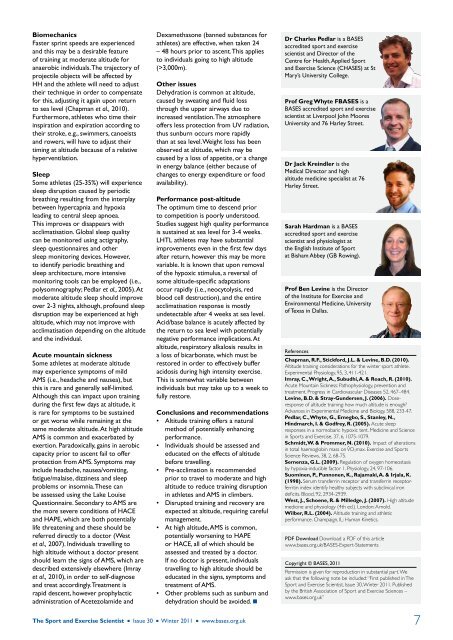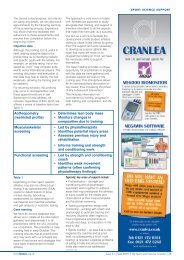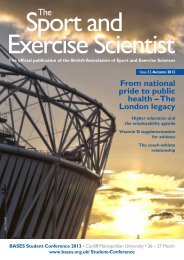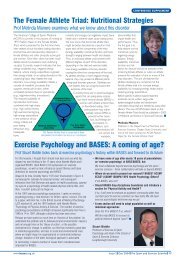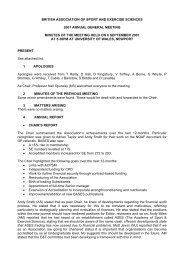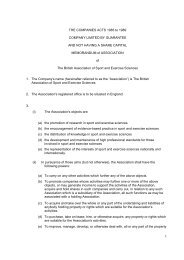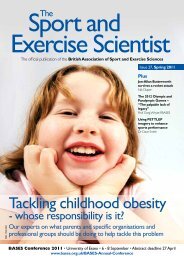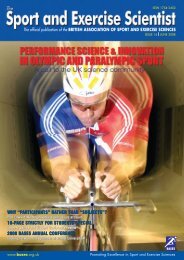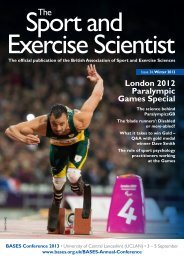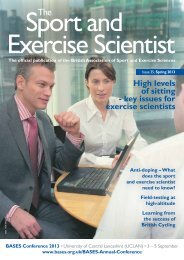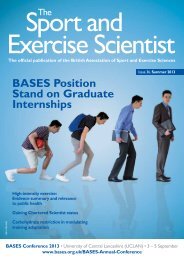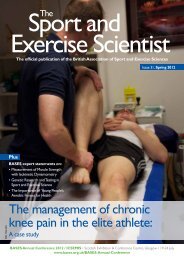The BASES Expert Statement on Human Performance in Hypoxia ...
The BASES Expert Statement on Human Performance in Hypoxia ...
The BASES Expert Statement on Human Performance in Hypoxia ...
You also want an ePaper? Increase the reach of your titles
YUMPU automatically turns print PDFs into web optimized ePapers that Google loves.
Biomechanics<br />
Faster spr<strong>in</strong>t speeds are experienced<br />
and this may be a desirable feature<br />
of tra<strong>in</strong><strong>in</strong>g at moderate altitude for<br />
anaerobic <strong>in</strong>dividuals. <str<strong>on</strong>g>The</str<strong>on</strong>g> trajectory of<br />
projectile objects will be affected by<br />
HH and the athlete will need to adjust<br />
their technique <strong>in</strong> order to compensate<br />
for this, adjust<strong>in</strong>g it aga<strong>in</strong> up<strong>on</strong> return<br />
to sea level (Chapman et al., 2010).<br />
Furthermore, athletes who time their<br />
<strong>in</strong>spirati<strong>on</strong> and expirati<strong>on</strong> accord<strong>in</strong>g to<br />
their stroke, e.g., swimmers, canoeists<br />
and rowers, will have to adjust their<br />
tim<strong>in</strong>g at altitude because of a relative<br />
hyperventilati<strong>on</strong>.<br />
Sleep<br />
Some athletes (25-35%) will experience<br />
sleep disrupti<strong>on</strong> caused by periodic<br />
breath<strong>in</strong>g result<strong>in</strong>g from the <strong>in</strong>terplay<br />
between hypercapnia and hypoxia<br />
lead<strong>in</strong>g to central sleep apnoea.<br />
This improves or disappears with<br />
acclimatisati<strong>on</strong>. Global sleep quality<br />
can be m<strong>on</strong>itored us<strong>in</strong>g actigraphy,<br />
sleep questi<strong>on</strong>naires and other<br />
sleep m<strong>on</strong>itor<strong>in</strong>g devices. However,<br />
to identify periodic breath<strong>in</strong>g and<br />
sleep architecture, more <strong>in</strong>tensive<br />
m<strong>on</strong>itor<strong>in</strong>g tools can be employed (i.e.,<br />
polysomnography; Pedlar et al., 2005). At<br />
moderate altitude sleep should improve<br />
over 2-3 nights, although, profound sleep<br />
disrupti<strong>on</strong> may be experienced at high<br />
altitude, which may not improve with<br />
acclimatisati<strong>on</strong> depend<strong>in</strong>g <strong>on</strong> the altitude<br />
and the <strong>in</strong>dividual.<br />
Acute mounta<strong>in</strong> sickness<br />
Some athletes at moderate altitude<br />
may experience symptoms of mild<br />
AMS (i.e., headache and nausea), but<br />
this is rare and generally self-limited.<br />
Although this can impact up<strong>on</strong> tra<strong>in</strong><strong>in</strong>g<br />
dur<strong>in</strong>g the first few days at altitude, it<br />
is rare for symptoms to be susta<strong>in</strong>ed<br />
or get worse while rema<strong>in</strong><strong>in</strong>g at the<br />
same moderate altitude. At high altitude<br />
AMS is comm<strong>on</strong> and exacerbated by<br />
exerti<strong>on</strong>. Paradoxically, ga<strong>in</strong>s <strong>in</strong> aerobic<br />
capacity prior to ascent fail to offer<br />
protecti<strong>on</strong> from AMS. Symptoms may<br />
<strong>in</strong>clude headache, nausea/vomit<strong>in</strong>g,<br />
fatigue/malaise, dizz<strong>in</strong>ess and sleep<br />
problems or <strong>in</strong>somnia. <str<strong>on</strong>g>The</str<strong>on</strong>g>se can<br />
be assessed us<strong>in</strong>g the Lake Louise<br />
Questi<strong>on</strong>naire. Sec<strong>on</strong>dary to AMS are<br />
the more severe c<strong>on</strong>diti<strong>on</strong>s of HACE<br />
and HAPE, which are both potentially<br />
life threaten<strong>in</strong>g and these should be<br />
referred directly to a doctor (West<br />
et al., 2007). Individuals travell<strong>in</strong>g to<br />
high altitude without a doctor present<br />
should learn the signs of AMS, which are<br />
described extensively elsewhere (Imray<br />
et al., 2010), <strong>in</strong> order to self-diagnose<br />
and treat accord<strong>in</strong>gly. Treatment is<br />
rapid descent, however prophylactic<br />
adm<strong>in</strong>istrati<strong>on</strong> of Acetezolamide and<br />
Dexamethas<strong>on</strong>e (banned substances for<br />
athletes) are effective, when taken 24<br />
– 48 hours prior to ascent. This applies<br />
to <strong>in</strong>dividuals go<strong>in</strong>g to high altitude<br />
(>3,000m).<br />
Other issues<br />
Dehydrati<strong>on</strong> is comm<strong>on</strong> at altitude,<br />
caused by sweat<strong>in</strong>g and fluid loss<br />
through the upper airways due to<br />
<strong>in</strong>creased ventilati<strong>on</strong>. <str<strong>on</strong>g>The</str<strong>on</strong>g> atmosphere<br />
offers less protecti<strong>on</strong> from UV radiati<strong>on</strong>,<br />
thus sunburn occurs more rapidly<br />
than at sea level. Weight loss has been<br />
observed at altitude, which may be<br />
caused by a loss of appetite, or a change<br />
<strong>in</strong> energy balance (either because of<br />
changes to energy expenditure or food<br />
availability).<br />
<strong>Performance</strong> post-altitude<br />
<str<strong>on</strong>g>The</str<strong>on</strong>g> optimum time to descend prior<br />
to competiti<strong>on</strong> is poorly understood.<br />
Studies suggest high quality performance<br />
is susta<strong>in</strong>ed at sea level for 3-4 weeks.<br />
LHTL athletes may have substantial<br />
improvements even <strong>in</strong> the first few days<br />
after return, however this may be more<br />
variable. It is known that up<strong>on</strong> removal<br />
of the hypoxic stimulus, a reversal of<br />
some altitude-specific adaptati<strong>on</strong>s<br />
occur rapidly (i.e., neocytolysis, red<br />
blood cell destructi<strong>on</strong>), and the entire<br />
acclimatisati<strong>on</strong> resp<strong>on</strong>se is mostly<br />
undetectable after 4 weeks at sea level.<br />
Acid/base balance is acutely affected by<br />
the return to sea level with potentially<br />
negative performance implicati<strong>on</strong>s. At<br />
altitude, respiratory alkalosis results <strong>in</strong><br />
a loss of bicarb<strong>on</strong>ate, which must be<br />
restored <strong>in</strong> order to effectively buffer<br />
acidosis dur<strong>in</strong>g high <strong>in</strong>tensity exercise.<br />
This is somewhat variable between<br />
<strong>in</strong>dividuals but may take up to a week to<br />
fully restore.<br />
C<strong>on</strong>clusi<strong>on</strong>s and recommendati<strong>on</strong>s<br />
• Altitude tra<strong>in</strong><strong>in</strong>g offers a natural<br />
method of potentially enhanc<strong>in</strong>g<br />
performance.<br />
• Individuals should be assessed and<br />
educated <strong>on</strong> the effects of altitude<br />
before travell<strong>in</strong>g.<br />
• Pre-acclimati<strong>on</strong> is recommended<br />
prior to travel to moderate and high<br />
altitude to reduce tra<strong>in</strong><strong>in</strong>g disrupti<strong>on</strong><br />
<strong>in</strong> athletes and AMS <strong>in</strong> climbers.<br />
• Disrupted tra<strong>in</strong><strong>in</strong>g and recovery are<br />
expected at altitude, requir<strong>in</strong>g careful<br />
management.<br />
• At high altitude, AMS is comm<strong>on</strong>,<br />
potentially worsen<strong>in</strong>g to HAPE<br />
or HACE, all of which should be<br />
assessed and treated by a doctor.<br />
If no doctor is present, <strong>in</strong>dividuals<br />
travell<strong>in</strong>g to high altitude should be<br />
educated <strong>in</strong> the signs, symptoms and<br />
treatment of AMS.<br />
• Other problems such as sunburn and<br />
dehydrati<strong>on</strong> should be avoided.<br />
<str<strong>on</strong>g>The</str<strong>on</strong>g> Sport and Exercise Scientist n Issue 30 n W<strong>in</strong>ter 2011 n www.bases.org.uk<br />
Dr Charles Pedlar is a <str<strong>on</strong>g>BASES</str<strong>on</strong>g><br />
accredited sport and exercise<br />
scientist and Director of the<br />
Centre for Health, Applied Sport<br />
and Exercise Science (CHASES) at St<br />
Mary’s University College.<br />
Prof Greg Whyte F<str<strong>on</strong>g>BASES</str<strong>on</strong>g> is a<br />
<str<strong>on</strong>g>BASES</str<strong>on</strong>g> accredited sport and exercise<br />
scientist at Liverpool John Moores<br />
University and 76 Harley Street.<br />
Dr Jack Kre<strong>in</strong>dler is the<br />
Medical Director and high<br />
altitude medic<strong>in</strong>e specialist at 76<br />
Harley Street.<br />
Sarah Hardman is a <str<strong>on</strong>g>BASES</str<strong>on</strong>g><br />
accredited sport and exercise<br />
scientist and physiologist at<br />
the English Institute of Sport<br />
at Bisham Abbey (GB Row<strong>in</strong>g).<br />
Prof Ben Lev<strong>in</strong>e is the Director<br />
of the Institute for Exercise and<br />
Envir<strong>on</strong>mental Medic<strong>in</strong>e, University<br />
of Texas <strong>in</strong> Dallas.<br />
References<br />
Chapman, R.F., Stickford, J.L. & Lev<strong>in</strong>e, B.D. (2010).<br />
Altitude tra<strong>in</strong><strong>in</strong>g c<strong>on</strong>siderati<strong>on</strong>s for the w<strong>in</strong>ter sport athlete.<br />
Experimental Physiology, 95, 3, 411-421.<br />
Imray, C., Wright, A., Subudhi, A. & Roach, R. (2010).<br />
Acute Mounta<strong>in</strong> Sickness: Pathophysiology, preventi<strong>on</strong> and<br />
treatment. Progress <strong>in</strong> Cardiovascular Diseases 52, 467–484.<br />
Lev<strong>in</strong>e, B.D. & Stray-Gundersen, J. (2006). Doseresp<strong>on</strong>se<br />
of altitude tra<strong>in</strong><strong>in</strong>g: how much altitude is enough?<br />
Advances <strong>in</strong> Experimental Medic<strong>in</strong>e and Biology, 588, 233-47.<br />
Pedlar, C., Whyte, G., Emegbo, S., Stanley, N.,<br />
H<strong>in</strong>dmarch, I. & Godfrey, R. (2005). Acute sleep<br />
resp<strong>on</strong>ses <strong>in</strong> a normobaric hypoxic tent. Medic<strong>in</strong>e and Science<br />
<strong>in</strong> Sports and Exercise, 37, 6, 1075-1079.<br />
Schmidt, W. & Prommer, N. (2010). Impact of alterati<strong>on</strong>s<br />
<strong>in</strong> total haemoglob<strong>in</strong> mass <strong>on</strong> VO2max. Exercise and Sports<br />
Science Reviews, 38, 2, 68-75.<br />
Semenza, G.L. (2009). Regulati<strong>on</strong> of oxygen homeostasis<br />
by hypoxia-<strong>in</strong>ducible factor 1. Physiology, 24, 97-106.<br />
Suom<strong>in</strong>en, P., Punn<strong>on</strong>en, K., Rajamaki, A. & Irjala, K.<br />
(1998). Serum transferr<strong>in</strong> receptor and transferr<strong>in</strong> receptorferrit<strong>in</strong><br />
<strong>in</strong>dex identify healthy subjects with subcl<strong>in</strong>ical ir<strong>on</strong><br />
deficits. Blood, 92, 2934-2939.<br />
West, J., Schoene, R. & Milledge, J. (2007). High altitude<br />
medic<strong>in</strong>e and physiology (4th ed.). L<strong>on</strong>d<strong>on</strong>: Arnold.<br />
Wilber, R.L. (2004). Altitude tra<strong>in</strong><strong>in</strong>g and athletic<br />
performance. Champaign, IL: <strong>Human</strong> K<strong>in</strong>etics.<br />
PDF Download Download a PDF of this article<br />
www.bases.org.uk/<str<strong>on</strong>g>BASES</str<strong>on</strong>g>-<str<strong>on</strong>g>Expert</str<strong>on</strong>g>-<str<strong>on</strong>g>Statement</str<strong>on</strong>g>s<br />
Copyright © <str<strong>on</strong>g>BASES</str<strong>on</strong>g>, 2011<br />
Permissi<strong>on</strong> is given for reproducti<strong>on</strong> <strong>in</strong> substantial part. We<br />
ask that the follow<strong>in</strong>g note be <strong>in</strong>cluded: “First published <strong>in</strong> <str<strong>on</strong>g>The</str<strong>on</strong>g><br />
Sport and Exercise Scientist, Issue 30, W<strong>in</strong>ter 2011. Published<br />
by the British Associati<strong>on</strong> of Sport and Exercise Sciences –<br />
www.bases.org.uk”<br />
7


